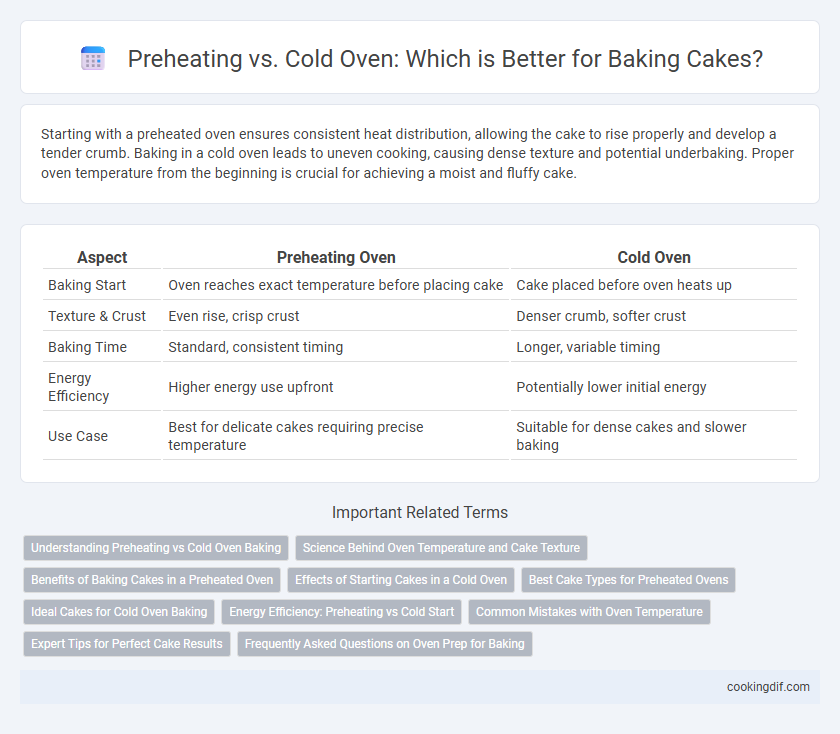Starting with a preheated oven ensures consistent heat distribution, allowing the cake to rise properly and develop a tender crumb. Baking in a cold oven leads to uneven cooking, causing dense texture and potential underbaking. Proper oven temperature from the beginning is crucial for achieving a moist and fluffy cake.
Table of Comparison
| Aspect | Preheating Oven | Cold Oven |
|---|---|---|
| Baking Start | Oven reaches exact temperature before placing cake | Cake placed before oven heats up |
| Texture & Crust | Even rise, crisp crust | Denser crumb, softer crust |
| Baking Time | Standard, consistent timing | Longer, variable timing |
| Energy Efficiency | Higher energy use upfront | Potentially lower initial energy |
| Use Case | Best for delicate cakes requiring precise temperature | Suitable for dense cakes and slower baking |
Understanding Preheating vs Cold Oven Baking
Preheating the oven ensures the cake batter begins baking at the ideal temperature, promoting proper rising and even texture by activating leavening agents like baking powder or baking soda immediately. Starting in a cold oven causes gradual temperature increase, which can result in uneven baking, denser crumb, and possible sinking as the batter heats too slowly for optimal chemical reactions. Understanding the difference between preheating and cold oven baking is crucial for achieving consistent cake structure and moistness.
Science Behind Oven Temperature and Cake Texture
Preheating the oven is crucial for consistent heat distribution, enabling proper batter rising and achieving a tender crumb in cakes. Starting in a cold oven causes uneven heat exposure, leading to denser texture and potential undercooking. Scientific studies show that stable oven temperatures facilitate Maillard reactions and optimal gluten structure, enhancing cake flavor and softness.
Benefits of Baking Cakes in a Preheated Oven
Baking cakes in a preheated oven ensures consistent and even heat distribution, resulting in a uniform rise and tender crumb structure. The immediate exposure to the correct temperature activates the leavening agents effectively, promoting optimal texture and preventing dense or undercooked centers. Starting with a preheated oven reduces baking time variability and enhances overall cake quality by stabilizing the baking environment from the outset.
Effects of Starting Cakes in a Cold Oven
Starting cakes in a cold oven often causes uneven rising and dense texture due to gradual heat exposure, which affects the cake's structure and crumb quality. The delayed activation of leavening agents like baking powder or baking soda can result in poor volume and increased baking time. A preheated oven ensures immediate heat, promoting optimal gas expansion and consistent batter setting for uniform crumb and golden crust formation.
Best Cake Types for Preheated Ovens
Preheating the oven is essential for delicate cakes like chiffon, sponge, and angel food, which require an immediate and consistent high temperature to rise properly and develop a tender crumb. Dense cakes such as pound cake or fruit cake benefit less from preheated ovens and can bake evenly in a cold oven. For optimal texture and rise, cakes with light batters and leavening agents perform best when placed in a fully preheated oven.
Ideal Cakes for Cold Oven Baking
Cold oven baking suits dense cakes like fruitcakes, pound cakes, and cheesecakes by allowing gradual heat penetration for even baking and moisture retention. Starting in a cold oven reduces crust cracking and prevents rapid rise collapse, ideal for recipes requiring long, slow baking times. This method enhances texture and flavor development, especially in rich, heavy batters that benefit from gentle heat exposure.
Energy Efficiency: Preheating vs Cold Start
Starting to bake with a preheated oven ensures consistent temperature control, reducing overall cooking time and energy consumption by preventing heat loss during baking. In contrast, placing cake batter in a cold oven causes temperature fluctuations that extend baking time and increase energy use due to prolonged heating. Energy-efficient baking is optimized by preheating, which maintains thermal stability critical for cake texture and even rising.
Common Mistakes with Oven Temperature
Starting to bake a cake in a cold oven can lead to uneven rising and dense texture due to improper initial temperature, frequently causing underbaked centers or overly browned edges. Preheating the oven to the recommended temperature ensures consistent heat distribution, promoting optimal cake structure and ideal crumb formation. Ignoring preheating is a common mistake that often results in altered baking times and unpredictable cake quality.
Expert Tips for Perfect Cake Results
Starting with a preheated oven ensures consistent heat distribution, promoting even cake rise and preventing dense or undercooked centers. Experts recommend setting the oven to the desired temperature before placing the cake inside, optimizing texture and crumb structure. Baking in a cold oven may cause uneven cooking and affect the cake's final volume and moisture retention.
Frequently Asked Questions on Oven Prep for Baking
Preheating the oven to the recommended temperature ensures even heat distribution, promoting consistent cake rising and optimal texture. Starting with a cold oven often leads to uneven baking and can cause cakes to be dense or undercooked in the center. For best results, always preheat the oven fully before placing the cake inside to guarantee the ideal baking environment.
Preheating oven vs Cold oven for baking start Infographic

 cookingdif.com
cookingdif.com